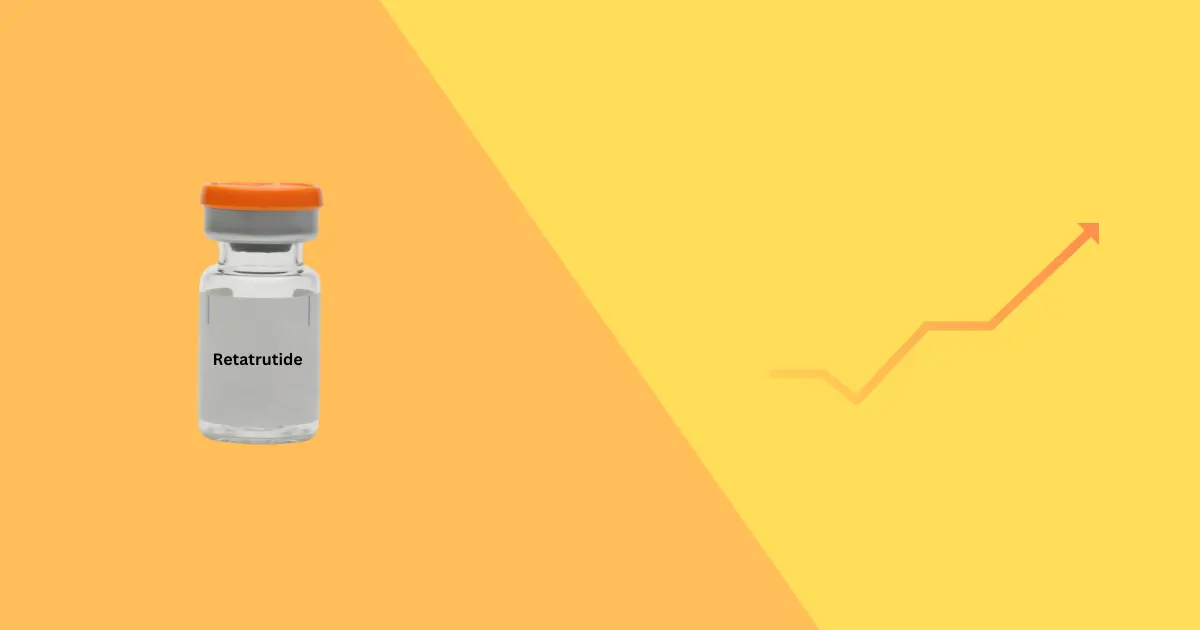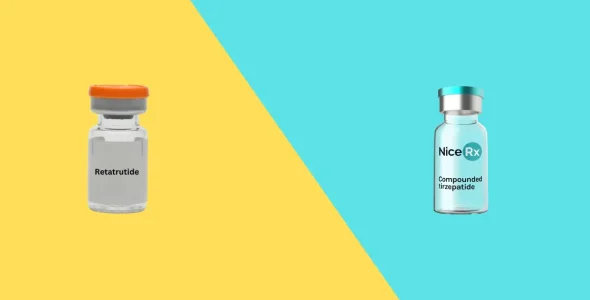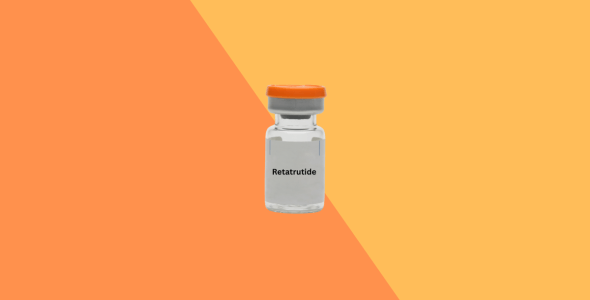Retatrutide dosage chart for weight loss: A comprehensive guide
Looking for the ultimate weight loss medication? Discover the key differences between retatrutide and semaglutide to find out which is right for you.
Key highlights
- Retatrutide is a peptide weight loss medication with triple agonism at GLP-1, GIP, and glucagon receptors. It enhances insulin release, dissolves fats, suppresses appetite, and lowers blood sugar levels to promote weight loss.
- Retatrutide dosage starts at a 1 mg and is administered subcutaneously once weekly. The dosage is titrated every 4 weeks.
- The maintenance dose of retatrutide depends on an individual's tolerance to the medication and can range from 4 mg, 8 mg, to 12 mg once weekly (maximum dose).
- Phase II clinical trials showed that participants using retatrutide lost 17.5% of their weight after 24 weeks and 24.2% after 48 weeks.
- The medication has successfully passed phase I and II clinical trials and is currently in phase III clinical trials. Retatrutide is expected to be commercially available in 2026 or 2027.
Retatrutide is the newest weight loss medication that acts as a triple agonist at GLP-1, GIP, and glucagon receptors. The medication is indicated for weight loss, type 2 diabetes and improving metabolic health in obese and overweight patients with other weight-related health conditions. Retatrutide has not yet been approved by the FDA. It has passed phase 1 and 2 clinical trials and is currently in phase 3 trials, with an expected launch in 2026 or 2027 if approved.
According to the 2025 World Obesity Atlas, the number of obese people will increase by 115% (from 524 million to 1.13 billion) between 2010 and 2030. The alarmingly high prevalence of obesity necessitates the need for more effective anti-obesity medications. Retatrutide is expected to be a blockbuster in weight loss treatment due to its unique mechanism of action.
Before you start the medication, it is essential to understand the dosage, titration schedule, and appropriate dosing for optimal results and safety.
This articles provides a clear and comprehensive overview of retatrutide dosage, including a retatrutide dosage chart, clinical trial data, side effects, and expert recommendations.
What is retatrutide and how does it work?
Retatrutide is a peptide-based weight loss medication for type 2 diabetes and obesity. It is a single peptide (with 39 amino acids) conjugated to a lipid diacid molecule. Manufactured by Eli Lilly, retatrutide is still in phase III clinical trials. The FDA has not approved it yet.
Currently, the manufacturer, Eli Lilly, has conducted TRIUMPH trials to check the efficacy of retatrutide in various health conditions, including obstructive sleep apnea, knee osteoarthritis, and type 2 diabetes. The medication is in phase III trials and is expected to be available in markets by the end of 2026 or 2027.
In a clinical study of mice, retatrutide and tirzepatide had superior efficacy in improving diabetic kidney disease, blood sugar control, and weight loss. Tirzepatide is more effective for blood sugar control, and retatrutide was most effective in managing diabetic kidney disease and body weight.
In phase 3 clinical trials, semaglutide (2.4 mg once weekly) participants showed 10-15% body weight reduction on average after 68 weeks. Meanwhile, tirzepatide participants lost body weight by 16%, 21.4%, and 22.5% on 5 mg, 10 mg, and 15 mg (once weekly injections), respectively, after 72 weeks.
In comparison, patients who used retatrutide (8 mg and 12 mg once weekly) lost 17.5% at 24 weeks and 24.2% of their body weight after 48 weeks in phase 2 clinical trials.
The safety profile of retatrutide was similar to other incretin-based medications.
These results project that retatrutide may have a greater efficacy than tirzepatide and semaglutide due to its triple action at GLP-1, GIP, and glucagon receptors. More research is still needed.
Retatrutide works like semaglutide (Ozempic and Wegovy) and tirzepatide (Mounjaro and Zepbound) to promote weight loss, but it acts at three receptors at once and exerts the following actions:
GLP-1 receptor agonism
As a glucagon-like peptide-1 (GLP-1) receptor agonist, retatrutide has the following effects:
- The medication increases insulin secretion and reduces glucagon secretion from the pancreas, which helps lower blood sugar levels.
- These receptors delay gastric emptying by relaxing stomach muscles. The food moves in your intestine slowly and stays in the stomach for a longer time, which reduces hunger cravings.
- It impacts the lateral hypothalamus to reduce appetite and increase satiety.
GIP receptor agonism
Retatrutide activates glucose-dependent insulinotropic polypeptide (GIP) hormone receptors to enhance insulin secretion and glucose reuptake in cells and slow down gastric emptying. These actions lower blood glucose levels, which contributes to weight loss and improved blood sugar control.
Glucagon receptor agonism
Glucagon receptor activation increases energy expenditure, improves liver health, and promotes fat breakdown. In the liver, retatrutide has similar efficacy to naturally occurring glucagon. However, in fat tissues, its ability to induce fat breakdown surpasses that of the native glucose-dependent insulinotropic hormone (GIP).
Synergistic effects
The combined activation of these three receptors boosts insulin sensitivity and release, slows down digestion, makes you feel full for a longer time, and reduces hunger pangs. It helps you eat less and lose weight.
Retatrutide dosage chart
Like other weight loss medications, retatrutide also follows a standard dosing protocol. Let’s get into the details of the retatrutide dosing schedule for weight loss:
Starting dose
Retatrutide is typically started at a low dose of 1 mg once weekly for the first 4 weeks.
Titration schedule (how dose is increased over time)
Retatrutide dose is escalated every 4 weeks if the patient can tolerate the existing dosage. The titration schedule is as follows:
- 1-4 weeks: The dosage starts at 1 mg once weekly for 4 weeks.
- 5-8 weeks: Your healthcare provider will increase the dosage to 2 mg once weekly.
- 9-12 weeks: If you can tolerate 2 mg once weekly, your dose will be increased to 4 mg once weekly for the next 4 weeks.
- 13-16 weeks: After assessment, your doctor will escalate the dosage to 8 mg once weekly for the next 4 weeks
- 17-21 weeks: If your body tolerates 8 mg for 4 weeks, your doctor will increase the dose to 12 mg once weekly onwards. This is the maximum dosage of retatrutide.
If your body cannot tolerate the higher doses, your healthcare provider will delay the dose escalation for the next 4 weeks and keep you on the existing dose. After 4 weeks, they will assess your tolerance and the severity of side effects again and adjust the dosage accordingly.
Maintenance dose
The maintenance dose of retatrutide depends on how much dosage an individual’s body can tolerate. It’s expected that 4 mg, 8 mg, and 12 mg once weekly will be the maintenance doses for retatrutide.
Maximum dose
The maximum dosage of retatrutide is 12 mg once weekly. You cannot take a higher dosage 12mg/weekly.
Retatrutide dosing schedule
| Week | Dosage | |
|---|---|---|
| Starting dosage | Weeks 1-4: | 1 mg once weekly |
| Dosage titration | Weeks 5-8: | 2 mg once weekly |
| Weeks 9-12: | 4 mg once weekly | |
| Weeks 13-16: | 8 mg once weekly | |
| Weeks 17-21: | 12 mg once weekly | |
| Maintenance dosage | 4 mg, 8 mg, 12 mg once weekly depending on patient's tolerance | |
| Maximum dosage | 12 mg once weekly |
Retatrutide dosage in clinical trials
A phase 1 clinical trial of retatrutide involved 72 individuals with diagnosed type 2 diabetes who received 12 mg once weekly retatrutide injections subcutaneously for 12 weeks. Participants who used retatrutide showed an average weight loss of 8.96 kg (or 10% of their body weight). The levels of glycated hemoglobin were reduced by -1.2%. Patients showed elevated insulin levels and a decrease in systolic blood pressure. There was also an improvement in the levels of low-density lipoprotein cholesterol, very low density lipoprotein cholesterol, and triglycerides in participants who received retatrutide compared to placebo, which did not show improvement.
Phase 2 clinical trials involved 338 adults with obesity (BMI 30 or more) and overweight (BMI of 27–29.99) with one or more weight-related conditions such as high blood pressure, high cholesterol levels, heart disease, and type 2 diabetes. The participants were divided into the following experimental groups or a placebo group:
- 1 mg of retatrutide (subcutaneously)
- 4 mg of retatrutide (subcutaneously), starting at an initial dose of 2 mg
- 4 mg of retatrutide (subcutaneously), starting at an initial dose of 4 mg
- 8 mg of retatrutide (subcutaneously), starting at an initial dose of 2 mg
- 8 mg of retatrutide (subcutaneously), starting at an initial dose of 4 mg
- 12 mg of retatrutide (subcutaneously), starting at an initial dose of 2 mg
Here are the detailed results of the trial at 24 weeks and 48 weeks:
| Group | Body Weight Change at 24 Weeks (%) | Body Weight Change at 48 Weeks (%) | 5% or More Weight Reduction at 48 Weeks (%) in participant | 10% or More Weight Reduction at 48 Weeks (%) | 15% or More Weight Reduction at 48 Weeks (%) | Changes in BMI |
|---|---|---|---|---|---|---|
| Placebo | -1.6 | -2.1 | 27% | 9% | 2% | −0.7 |
| 1 mg subcutaneous retatrutide | -7.2 | -8.7 | 64% | 27% | 16% | −3.2 |
| 4 mg subcutaneous retatrutide, starting at an initial dose of 2 mg | -11.8 | -16.3 | 87% | 73% | 55% | -6.1 |
| 4 mg of subcutaneous retatrutide, starting at an initial dose of 4 mg | -13.99 | -17.8 | 97% | 76% | 64% | -6.7 |
| 8 mg subcutaneous retatrutide starting at an initial dose of 2 mg | -16.7 | -21.7 | 100% | 90% | 73% | -8.1 |
| 8 mg subcutaneous retatrutide starting at an initial dose of 4 mg | -17.9 | -23.9 | 100 | 91% | 77% | -9 |
| 12 mg starting at the dose of 2 mg | -17.5 | -24.2 | 100% | 93% | 83% | −9.1 |
Phase II clinical trial projects promising results of retatrutide in weight management. However, phase III research clinical studies are still pending to evaluate the effect of retatrutide in weight management and its impact on weight-related health issues such as obstructive sleep apnea, osteoarthritis, and non-alcoholic fatty liver disease (NAFLD).
Factors influencing retatrutide dosing for weight loss
Several factors may influence the optimal dosage for an individual, such as:
- Body weight and BMI: Individuals with higher body mass index may need retatrutide treatment for a longer time and at higher doses to achieve significant weight loss.
- Individual weight loss goals: Some patients are stratified with minor weight loss changes and do not aim to lose a lot of weight. They may not need higher doses.
- Tolerance to the medication: The dosage of retatrutide also depends on an individual’s tolerance to the medication. If a patient experiences side effects, the dose escalation is delayed.
- Comorbidities: Other metabolic conditions, such as the presence of type 2 diabetes, osteoarthritis, obstructive sleep apnea, and heart disease, also influence the effect of medication.
- Interaction with other medications: Some medications like antihyperglycemic drugs (such as insulin and sulfonylureas), androgens, and beta blockers may lower glucose levels when used along with retatrutide. Inform your doctor if you are using any of these medications.
Based on these factors, healthcare providers will create a customized treatment plan for each individual. If you plan to start retatrutide treatment, consult your healthcare professional first to discuss whether it is the right choice for you. Do not try to increase the dosage on your own, as it can result in serious side effects. Always ask your doctor about dose adjustments.
Retatrutide titration: Why it matters
Titration is a process of gradually increasing the dose of a medication. Retatrutide dosage is titrated every 4 weeks. Your healthcare provider increases the dosage of retatrutide gradually every 4 weeks to minimize the risk of side effects. If you experience side effects, the dose escalation will be delayed for 4 weeks.
Retatrutide is started at a low dose. Slowly, the body starts to adjust its metabolism and tolerate the medication with minimal side effects. Increasing the dosage quickly or starting retatrutide at high doses can result in serious side effects.
Retatrutide dosage and side effects
Retatrutide is still in clinical trials. Its safety and efficacy have not been determined. However, phase I and II clinical trial results have shown that although retatrutide has promising results for weight loss, it may have a few side effects to consider.
In the Phase II trial, 73% to 94% of participants reported side effects with retatrutide, especially at the higher doses of 8 mg and 12 mg once weekly. The most common side effects were:
- Nausea
- Vomiting
- Diarrhea
- Constipation
- Fatigue
- Abdominal discomfort
- Early satiety
- Injection site reactions
- Increased heart rate in the first 24 weeks, but that returned to normal after 24 weeks.
Serious side effects of the medication include the following:
- Allergic or hypersensitivity reaction
- Severe gastrointestinal issues
- Changes in mood and behavior
- Pancreatitis
- Liver problems
- Low blood sugar levels (hypoglycemia)
- Cardiac arrhythmias
- Suicidal ideation
- Major depressive disorder
No adverse event of hypoglycemia or thyroid cancer was reported in Phase II trials, and 7% of retatrutide participants had skin sensitivity, compared to 1% on placebo, but these cases were not serious.
Tips for managing side effects
- Always start with the low dose to minimize the risk of side effects.
- Do not escalate the dosage too quickly, as it can cause severe side effects.
- Stay hydrated and eat in smaller portions to prevent nausea and constipation.
- Take a diet rich in dietary fiber and protein.
- Mild side effects usually vanish with time. If they persist, consult your healthcare provider.
- If you experience an allergic reaction or hypoglycemia, immediately consult a nearby healthcare facility for emergency care.
- If you experience serious side effects, stop taking the medication. Do not take the next dose without consulting your doctor.
How to use retatrutide: A step-by-step guide
Retatrutide is administered subcutaneously (under the skin just above your muscles) once weekly. Here is a step-by-step guide on how to inject retatrutide:
- Wash your hands thoroughly with soap and water.
- Collect all necessary items, such as a retatrutide pen (pre-filled syringe or vial as prescribed), an alcohol swab, a cotton ball or gauze pad, and a sharps disposal container for used needles.
- Check the expiration date on the retatrutide pen or vial. Never use the medication if it has expired. Ensure the medication is clear and free from particles or discoloration. If it seems cloudy or has visible particles, discard it and contact your healthcare provider.
- Do not shake the pen or vial. Gently roll the vial to mix if needed.
- Choose a suitable injection site, such as the upper thigh, arm, or abdomen, and clean the area of skin with an alcohol swab. Let it dry completely.
- Change the injection site each time to prevent irritation and reduce the risk of skin site infections.
- Remove the cap from the retatrutide pen or syringe and attach a new needle if you are using a syringe. If you use a pen, ensure that the needle is properly attached. If you are using a syringe, draw the prescribed amount of retatrutide from the vial. Remove any air bubbles by tapping the syringe and pushing the plunger slightly.
- Hold the syringe or pen at a 90-degree angle to the skin (unless instructed otherwise) and insert the needle swiftly and firmly into the skin at the chosen injection site.
- Push the plunger or activate the pen to deliver the medication. Hold the needle in place for a few seconds after injecting the medication to ensure it has been delivered completely. Gently withdraw the needle from the skin.
- Dispose of the needle immediately in a sharps container.
- Apply gentle pressure to the injection site with a cotton ball or gauze pad.
- Record the dosage of injection, time, date, and injection site in your journal or tracking app to show it to your healthcare professional.
Retatrutide dosage for special populations
Retatrutide dosage may vary for the elderly, patients with chronic kidney disease, liver and kidney failure, diabetes, cardiovascular disease, and other health conditions. However, the dosage variations have not been studied yet. Researchers may test retatrutide dosage for special populations once the medication is FDA approved and available in the market.
What to do if you miss a dose
If you have missed a dose of retatrutide, you can take it within 5 days of the scheduled date. If the scheduled date was more than 5 days ago, skip the dose and take the next scheduled dose according to your treatment plan. For example, your dose was scheduled on Monday, and you forgot to take it, you can administer the missed dose until Friday. If you remember about the missed dose after Friday, skip the dosage and take the next one on Monday.
If you have missed 2 or more doses, consult your healthcare provider for guidance on dose adjustments.
Retatrutide dosage FAQs
What is the starting dose of retatrutide?
The starting dosage of retatrutide is 1 mg once weekly (subcutaneously).
How quickly can the dose be increased?
Retatrutide dosage is generally increased every 4 weeks. However, keep in mind that it is not necessary to escalate the dose after every 4 weeks. If you experience side effects, your doctor will delay dose escalation for 4 weeks. After that, they will assess your condition and plan dose escalation accordingly.
Can you adjust the dosage for better weight loss results?
Your healthcare professional can adjust the dosage for better weight loss results. Do not try to change or adjust the dosage of retatrutide on your own. Your doctor will assess your condition, inquire about side effects, check blood sugar levels, review your medical history, and then adjust the dosage for better weight loss results.
What happens if you take too much retatrutide?
If you take too much retatrutide, you may experience serious side effects such as severe nausea, vomiting, diarrhea, stomach paralysis, severe gastrointestinal issues, and low blood sugar levels. You may require hospitalization after the drug overdose.
Conclusion
Retatrutide is a single peptide conjugated to a lipid diacid molecule. Manufactured by Eli Lilly, the medication has successfully passed phase I and II clinical trials and is currently in phase III trials. It is emerging as a novel medication for the treatment of obesity.
Retatrutide dosage starts with 1 mg once weekly that is injected subcutaneously. The dosage is started at lower doses and increased gradually to prevent the risk of side effects. Healthcare providers increase retatrutide dosage every 4 weeks after assessing an individual’s health condition. If the patient experiences side effects, the dosage escalation is delayed for 4 weeks. After 4 weeks, they assess the patient’s tolerance and severity of side effects and adjust the dosage accordingly.
If you plan to start retatrutide treatment for weight loss, consult your healthcare provider who will review your medical history, health goals, and decide if the medication is right for you.




